THE CRIKVENICA RIVIERA
Jadranovo, Dramalj, Crikvenica, Selce
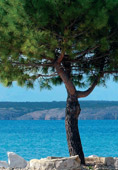 The
mildness of the microclimate is a specific feature of this area,
founded on Illiric and ancient heritage, characterized by Frankopan
traces, developed by K.& K. touch, this is a kilometres long, mild
and green coastal area, crowned by a long tourist tradition.
Protected bays, parks, villas and gardens follow in a series along
the promenade, while paths and mountain tracks lead to the
luxuriant, mountainous hinterland.
The
mildness of the microclimate is a specific feature of this area,
founded on Illiric and ancient heritage, characterized by Frankopan
traces, developed by K.& K. touch, this is a kilometres long, mild
and green coastal area, crowned by a long tourist tradition.
Protected bays, parks, villas and gardens follow in a series along
the promenade, while paths and mountain tracks lead to the
luxuriant, mountainous hinterland.
CRIKVENIČKO ŠETALIŠTE
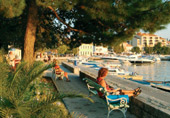 On
the Northwestern part of Kvarner, on the wide, mild slope of the
littoral crest, along the banks of the Vinodol channel, facing the
island of Krk, lies the Crikvenica Riviera. Protection from direct
blows of the «bora», with plenty of sun (some 2500 hours of
sunshine), pleasant and mild winters (January 5oC), warm and long
summers (July 23oC) are some of the climatic advantages thanks to
which the Riviera is a health, holiday and recreational centre
throughout the year. Stretching for eight kilometres along the sea
coast, the Riviera of Crikvenica is a long, recognizable and
beautiful promenade more than one hundred years old, extending (with
the exception of Jadranovo) all along the coast, and narrating the
glorious tourist story of the Crikvenica region: a story permeated
with the sea, Mediterranean vegetation,
On
the Northwestern part of Kvarner, on the wide, mild slope of the
littoral crest, along the banks of the Vinodol channel, facing the
island of Krk, lies the Crikvenica Riviera. Protection from direct
blows of the «bora», with plenty of sun (some 2500 hours of
sunshine), pleasant and mild winters (January 5oC), warm and long
summers (July 23oC) are some of the climatic advantages thanks to
which the Riviera is a health, holiday and recreational centre
throughout the year. Stretching for eight kilometres along the sea
coast, the Riviera of Crikvenica is a long, recognizable and
beautiful promenade more than one hundred years old, extending (with
the exception of Jadranovo) all along the coast, and narrating the
glorious tourist story of the Crikvenica region: a story permeated
with the sea, Mediterranean vegetation,
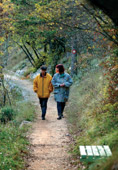 impressive
buildings and monuments and, in particular, a story on the diligent
inhabitants of the Kvarner region. One should only head to the sea.
The coastal path by the seaside is the Crikvenica promenade. It
begins (or ends) in the Slana Bay in Selce, i.e. on the cape Kačjak
in Dramalj. It has neither particular marks nor a specific name.
Along this unique, uninterrupted line, one-way streets follow one
after the other sharing all the same denominator - promenade (of:
Ivan Jelčićić, Emil Antić, Vladimir Nazor, Strossmayer, Gaj…)
impressive
buildings and monuments and, in particular, a story on the diligent
inhabitants of the Kvarner region. One should only head to the sea.
The coastal path by the seaside is the Crikvenica promenade. It
begins (or ends) in the Slana Bay in Selce, i.e. on the cape Kačjak
in Dramalj. It has neither particular marks nor a specific name.
Along this unique, uninterrupted line, one-way streets follow one
after the other sharing all the same denominator - promenade (of:
Ivan Jelčićić, Emil Antić, Vladimir Nazor, Strossmayer, Gaj…)
Let the Crikvenica promenade carry you away. The most tenacious ones
- and those who are in better shape - will conquer it in a single
day, while the others can walk:
- from hotel Kaštel to hotel Omorika
- from hotel Omorika to the Kačjak peninsula in Dramalj
- from hotel Kaštel to the Slana Bay in Selce
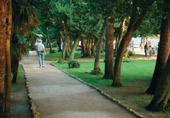
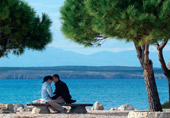
FROM HOTEL KAŠTEL TO HOTEL OMORIKA
The numerous attractions to be met on
this path make it extremely exciting. These attractions, embraced by
the secular vegetation of the Crikvenica parks follow each other.
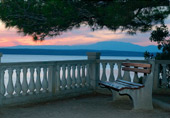 The
best starting point is the centre of Town, the so called “Cirkul”,
Stjepan Radić Square in front of Hotel International, continuing
towards the coastal promenade Palada, passing Hotel Kaštel, and then
via Frankopanska street to the Square again and, along the coast, to
the principal public beach, Crni mol and further on to Hotel
Omorika. The sights, symbols of the Crikvenica recognizability
follow the same direction.The combination of green vegetation and
sea, of cultivated parks, gardens, and of the well-known beaches
give the impression of a unique and large park along the seaside,
while in fact these are several parks that originated in different
periods of time. Here is the Park in memory of the Fallen, Park on
Petak (1898), the Big Park (once Small Park, 1926), the one from the
Town port to the main beach, the park (once Big Park, 1902) between
hotel Miramare and Esplanade, in front of Hotel Therapia. In the
largest park, the one extending from the town port to Hotel
Miramare, the promenade forks off in three paths, the “dynamic” one,
near hotels, restaurants, cafes, stores, open air ateliers, the most
pleasant one in summer, the central one, that passes through the
park, roofed over by vegetation throughout its length and the best
known, the promenade stretching along the beaches, with a view on
the sea, the Vinodol channel and the nearby island of Krk. In this
green cover, the most prominent are laurel (Laurus), holm oaks
(Nigella) various types of elm (Ulmus), and – owing to their
singularity and to the legend, the big platanes (Platanus sp.) stand
out in front of the town hall, mulberry (Morus), the small mulberry
“Murvica” on the square and that on Petak as well as the palms,
particularly those in front of the public reading room. Here extends
also the well-known, long sandy public beach (1910). With the
prestigious European blue flag that it has successfully defended,
from year to year and with good reason, its peculiarities, quality
and its numerous programmes are some of the reasons to pay it a
visit.
The
best starting point is the centre of Town, the so called “Cirkul”,
Stjepan Radić Square in front of Hotel International, continuing
towards the coastal promenade Palada, passing Hotel Kaštel, and then
via Frankopanska street to the Square again and, along the coast, to
the principal public beach, Crni mol and further on to Hotel
Omorika. The sights, symbols of the Crikvenica recognizability
follow the same direction.The combination of green vegetation and
sea, of cultivated parks, gardens, and of the well-known beaches
give the impression of a unique and large park along the seaside,
while in fact these are several parks that originated in different
periods of time. Here is the Park in memory of the Fallen, Park on
Petak (1898), the Big Park (once Small Park, 1926), the one from the
Town port to the main beach, the park (once Big Park, 1902) between
hotel Miramare and Esplanade, in front of Hotel Therapia. In the
largest park, the one extending from the town port to Hotel
Miramare, the promenade forks off in three paths, the “dynamic” one,
near hotels, restaurants, cafes, stores, open air ateliers, the most
pleasant one in summer, the central one, that passes through the
park, roofed over by vegetation throughout its length and the best
known, the promenade stretching along the beaches, with a view on
the sea, the Vinodol channel and the nearby island of Krk. In this
green cover, the most prominent are laurel (Laurus), holm oaks
(Nigella) various types of elm (Ulmus), and – owing to their
singularity and to the legend, the big platanes (Platanus sp.) stand
out in front of the town hall, mulberry (Morus), the small mulberry
“Murvica” on the square and that on Petak as well as the palms,
particularly those in front of the public reading room. Here extends
also the well-known, long sandy public beach (1910). With the
prestigious European blue flag that it has successfully defended,
from year to year and with good reason, its peculiarities, quality
and its numerous programmes are some of the reasons to pay it a
visit.
![]() Slow-pace walk: 40 minutes
Slow-pace walk: 40 minutes
FROM HOTEL KAŠTEL TO THE SLANA BAY
The promenade leads to the picturesque Selce. The coastal path leads
through an olive-grove that once used to be the biggest in the
Croatian littoral region and that today is an only partially
preserved olive-grove. Today gardens, villas, holiday resorts and
hotels stand in its place. Selce attracts many visitors with its
position, preserved historical nucleus and proximity to the
sea.Breakwaters, stone bitts, sources – washing places, renovated
quay, parks (1918), bathing resorts (Blue flags), hotels (Selce
1986, Slaven 1911/12), camps, restaurants and konobas, create the
atmosphere of a genuine littoral small town. The small church (1498)
and the parish church (1886) of St. Catherine, St. Joseph’s Chapel
(18th century), Fresco painting in the mortuary and the partisan
memorial graveyard (H. Kujund ia) form a special whole, surrounded
by high, dark green cypresses, symbols of the visual identity of the
place. The luxuriant crown of the huge secular oak tree hangs over
this picture. It is worth pausing here, sitting down to absorb the
strength and peace that surround you. The “Old School” Gallery
(1878), the Education Centre (1931), the library (1873), places of
worship and chapels, olive grindstone and the once famous picture
gallery are only some of the additions to the picturesque Selce
landscape.
![]() Walk duration: one hour
Walk duration: one hour
Hiking opportunities (inquire in the
info centre):
- to the votive church of St. Fabijan and Sebastijan (1849)
- to the prehistoric embankment and the Gothic church of St. Juraj
(marvellous view)
- to the Borići memorial
- to the Povilac Bay and the Jesenova Bay memorial
FROM HOTEL OMORIKA TO THE KAČJAK PENINSULA
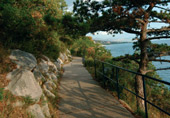 The
promenade covers the coastal part of Dramalj (Sveta Jelena). Villas,
gardens, hotels (Riviera) and restaurants follow in a series along
the coastal path, up to the Kačjak peninsula, the
sports-recreational centre. A promenade out of cars’ reach and
touched only by parts of the trim track, accompanies the sea line.
In Pazdehova Bay stands a monument to the local economy - toš (olive
grinder) “with monolytic millstone and other devices». In summer,
the very popular folk festivities are held here.
The
promenade covers the coastal part of Dramalj (Sveta Jelena). Villas,
gardens, hotels (Riviera) and restaurants follow in a series along
the coastal path, up to the Kačjak peninsula, the
sports-recreational centre. A promenade out of cars’ reach and
touched only by parts of the trim track, accompanies the sea line.
In Pazdehova Bay stands a monument to the local economy - toš (olive
grinder) “with monolytic millstone and other devices». In summer,
the very popular folk festivities are held here.
![]() Walk duration: one hour
Walk duration: one hour
|
|
Town of
Crikvenica Tourism Office phone 051/241 051 www.tzg-crikvenice.hr tz-grada-crikvenice@ri.t-com.hr Selce Tourism Office Dramalj Tourism Office |
PATHS AND MOUNTAIN TRACKS
The Jadranovo tourist tracks – between the Perčin and Havišće bays,
traced through the pine wood and the specific littoral vegetation,
connect sheltered beaches and bays. One of the paths leads to the
Lokvišće Bay, famous for its curative mud and the archeological
site.
![]() Walking
time: 40 minutes
Walking
time: 40 minutes
Path length : 2500 metres
Drenin is the highest peak of the littoral ri dge overlooking Crikvenica (380m) with traces of an Illyric fort. The marked path starts from the stone bridge and, near the top, makes its way through the macchia. A view on Vinodol, the Vinodol Channel, the island of Krk and Učka extends from the peak
![]() Walking
time: one hour and twenty minutes
Walking
time: one hour and twenty minutes
Love path – marked path, built in the 1930s, leads through the wood
covered part of the Crikvenica hinterland from Vinodolska street to
the Badanj fort where a view on the Vinodolska valley extends.
![]() Walking
time: one hour
Walking
time: one hour
Path length 2000m
We single out:
- the path to Kotor and Dolac (culturalhistoric and archeological
significance)
- Natural monument – old oak trees in Guljanov dolac
|
|
Jadranovo
Tourism Office phone 051/788 567 tz-jadranovo@ri.t-com.hr |

